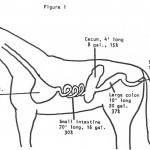One of the greatest expenses of owning a horse is feed cost. This expense can be minimized by maintaining the health of your animal, feeding a balanced ration and purchasing feeds that fulfill all nutrient requirements.
Many problems with horses are a result of either overfeeding or underfeeding. Horsemen must understand the horse’s digestive system.
Anatomy of the Digestive System
The digestive system of the horse is different than that of other farm animals. As indicated in Figure 1, the horse’s stomach is quite small. The stomach holds a maximum of 2 to 4 gallons, which is only about 8% of the horse’s digestive tract. The small intestine makes up about 30% of the horse’s digestive tract and is the major site of nutrient absorption. Approximately 65% to 70% of all nutrients are absorbed in the small intestine.
The feed passes through the horse’s stomach and small intestine in one to two hours. In a normal system of digestion, grain and highly digestible nutrients are used in the stomach and small intestine.
The next structure in the digestive system is the cecum, which is basically a fermentation vat responsible for breaking down roughages, such as grass and hay, into useful energy for the horse. The cecum and the large intestine, known as the colon, make up almost 65% of the digestive tract but are responsible for only 25% of the nutrient absorption.
Dangers of Overfeeding
The small stomach and rapid rate of feed passage through the small intestine indicates that a horse must be fed relatively small amounts of feed on a regular basis. In nature, the horse is basically a continuous eater. The advantage of the rapid rate of passage through the stomach and small intestine is that, within a couple of hours after feeding, the horse can normally be ridden without danger of digestive problems.
If the horse is fed large amounts of grain, the undigested feed may move through the upper portion of the tract and overwhelm the lower gut. Grain that is passed into the cecum and large colon is fermented, which normally results in production of gas and gaseous colic. This can make horses susceptible to digestive problems if large amounts of grain are fed.
Feed and Forage Go Hand in Hand
The lower gut, namely the cecum and colon, are relatively inefficient in the digestive and absorptive process. As a result, it is difficult to feed horses on forage alone. Therefore, animals that have any additional requirement other than maintenance, such as performance horses, growing foals and lactating mares, will need additional high-quality feeds. High quality hay and forage are needed to achieve adequate use.
Forages move through the digestive system more slowly than do grains. By feeding hay before grain, the grain portion of the ration can be slowed down through the digestive system and use of the grain is increased as well as reducing the potential for overloading the hind gut. To use the digestive system of the horse properly, horsemen must feed high quality forages and small amounts of grain regularly.
LSU Ag Center – Cinton Depew & Howard Cormier
